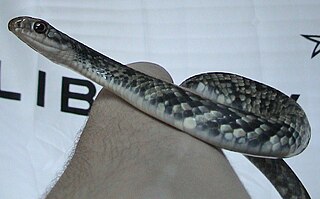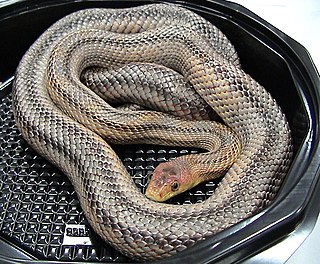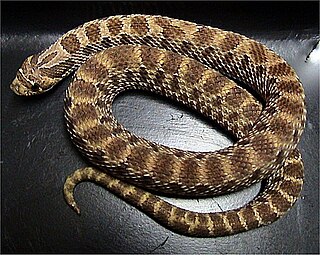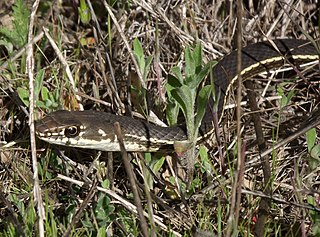
Pantherophis obsoletus, also known commonly as the western rat snake, black rat snake, pilot black snake, or simply black snake, is a nonvenomous species of snake in the family Colubridae. The species is native to central North America. There are no subspecies that are recognized as being valid. Its color variations include the Texas rat snake. Along with other snakes of the eastern United States, like the eastern indigo snake and the eastern racer, it is called “black snake”.

Masticophis flagellum is a species of nonvenomous colubrid snake, commonly referred to as the coachwhip or the whip snake, which is endemic to the United States and Mexico. Six subspecies are recognized, including the nominotypical subspecies.

Tropidoclonion is a genus of snake in the subfamily Natricinae of the family Colubridae. The genus is monotypic, containing the sole species Tropidoclonion lineatum, commonly known as the lined snake. The species is endemic to North America.

Coluber constrictor flaviventris, commonly known as the eastern yellow-bellied racer, is a subspecies of the eastern racer, a non-venomous colubrid snake. It is endemic to North America.

The Trans-Pecos rat snake or Davis Mountain rat snake, is a species of medium to large, nonvenomous rat snake in the family Colubridae. Bogertophis subocularis is endemic to the Chihuahuan Desert.

The eastern racer, or North American racer, is a species of nonvenomous snake in the family Colubridae. The species is endemic to North America and Central America. Eleven subspecies, including the nominotypical subspecies, are recognized, which as a group are commonly referred to as the eastern racers. The species is monotypic in the genus Coluber.

Hypsiglena jani, commonly known as the Texas night snake or the Chihuahuan night snake, is a small species of mildly venomous snake in the subfamily Dipsadinae of the family Colubridae. The species is native to the southwestern United States and adjacent northeastern Mexico.

Coluber constrictor oaxaca, commonly known as the Mexican racer, is a nonvenomous colubrid snake, a subspecies of the eastern racer.

The Texas scarlet snake is a species of nonvenomous snake in the family Colubridae. The species is endemic to the South Central United States. It was previously considered a subspecies of Cemophora coccinea.

Pantherophis emoryi, commonly known as the Great Plains rat snake, is a species of nonvenomous rat snake in the family Colubridae. The species is native to the central part of the United States, from Missouri to Nebraska, to Colorado, south to Texas, and into northern Mexico.

Pantherophis bairdi is a species of harmless snake in the family Colubridae. The species is native to the southwestern United States and adjacent northeastern Mexico. No subspecies are recognized as being valid.

The western hognose snake is a species of snake in the family Colubridae. The species is endemic to North America. There are three subspecies that are recognized as being valid, including the nominotypical subspecies.

The banded water snake or southern water snake is a species of mostly aquatic, nonvenomous, colubrid snakes most commonly found in the Midwest, Southeastern United States.

Regina grahamii, commonly known as Graham's crayfish snake, is a species of nonvenomous semiaquatic snake in the subfamily Natricinae of the family Colubridae. The species is endemic to the central United States.

The crayfish snake, also known commonly as the glossy crayfish snake, the glossy swampsnake, the glossy water snake, and the striped water snake, is a species of semiaquatic snake in the subfamily Natricinae of the family Colubridae. The species is endemic to the southeastern United States, and preys mainly on crayfish.

The California whipsnake, also known as the striped racer, is a colubrid snake found in habitats of the coast, desert, and foothills of California.

The striped whipsnake is a species of nonvenomous snake in the family Colubridae. It is closely related to the California whipsnake. The striped whipsnake is native to the western United States and adjacent northern Mexico.

The northern redbelly snake is a nonvenomous snake in the family Colubridae, a subspecies of Storeria occipitomaculata. It is native to North America.

The southern ribbon snake(Thamnophis saurita sackenii), also known commonly as the peninsula ribbon snake and the Florida ribbon snake, is a subspecies of garter snake in the family Colubridae. It is one of four subspecies of the ribbon snake.

The northern black racer is a subspecies of the eastern racer, a nonvenomous snake in the family Colubridae. Their geographic range extends from southern Maine to northern Georgia and westward to central Kentucky and eastern Ohio. Their occupancy is dependent on the availability of large patches of open habitats.




















